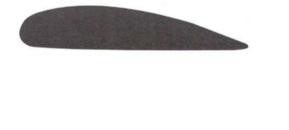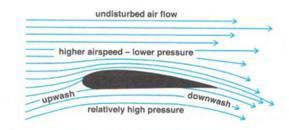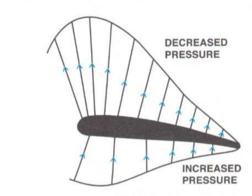Lift
Fixed wing or helicopter, when you break it down to the basics they both create lift in the same way. Their wings may look different but airplanes and helicopters both use an airfoil to create lift.

An airfoil is any surface designed to create lift. The air doesn’t care if your wing is stuck to your side or whipping around your head. They are both subject to the laws of physics. Don’t worry; we’re going to keep it simple.
A long time ago to very smart people came up with some theories that show how lift is created. You may have heard of them, Newton and Bernoulli. We’ll take at look at Newton first.
Cast your mind back to High School, your age may determine how clear this memory is, but at some point you would have learnt about Newton’s three laws. Air is a fluid, which has inertia; this is where Newton’s first law comes in. A body in motion will stay in motion until a force is applied. For us this means air will continue to do it’s thing until we change it. Putting an airfoil in the air will apply a force to the air that will change its direction. This is Newton’s second law.
 Now we’ve altered the flow of the air we can talk about Newton’s third law. This is the one most people remember, equal and opposite. Airfoils can direct the airflow in any direction depending on their design and how they are mounted. For the most part we want to go up, so equal and opposite means we must be deflecting the air down.
Now we’ve altered the flow of the air we can talk about Newton’s third law. This is the one most people remember, equal and opposite. Airfoils can direct the airflow in any direction depending on their design and how they are mounted. For the most part we want to go up, so equal and opposite means we must be deflecting the air down.
image courtesy Aviation Publishers / From the Ground Up
Newton is only part of the story. As you can see from the image above we also need to talk about pressures. The pressure above the airfoil is lower than the pressure below it. Bernoulli’s Principle can explain this.
Bernoulli discovered that energy in a system remains constant. This means a fluid passing through the restriction in a Venturi tube will speed up. To allow this speed change some other form of energy must be reduced. In this case it’s pressure.

Air does the same when passing over an airfoil. Above the airfoil will be air undisturbed by it. The curved surface reduces the amount of space between it and the undisturbed airflow above it. The speed increases and the pressure drops. Air will always try to equalize it’s self. The higher-pressure air underneath will try to go up and replace the lower pressure air above it helping create lift.
image courtesy Aviation Publishers / From the Ground Up
We could of course get far more technical on the theory of lift but this will hopefully give you a good understanding of the basics. Be sure to check back in the near future where we will continue our series on helicopter ground school.